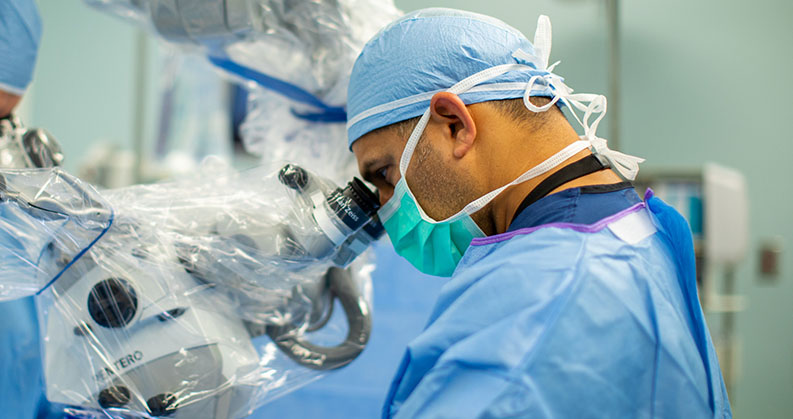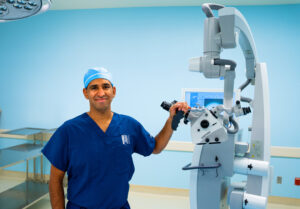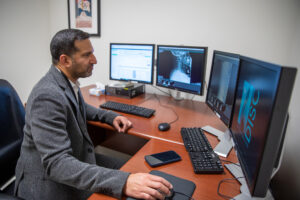
Spine surgery has undergone significant changes over the past decade that have transformed the field. New technologies, evolving surgical techniques and innovative implants are allowing surgeons to enhance outcomes and improve patient satisfaction.
“Cases are moving to ambulatory surgery centers (ASCs), motion preservation is being prioritized and more informed patients are seeking out surgeons who provide cutting-edge care,” said Steve Sanderson, Vice President of Marketing at Centinel Spine.
It’s an exciting time in the largest segment in orthopedics. The specialty is poised to push the boundaries of what’s possible in high-tech, minimally invasive care.

Dr. Nick Jain, who performs a variety of spine procedures at DISC Sports & Spine Center, said the benefits of minimally invasive spine surgery are increasing demand for outpatient care.
The Site-of-Care Shift
Over the past decade, spine cases have increasingly moved from inpatient hospitals to outpatient facilities. This shift has been the most significant trend in spine care. The movement of cases has been driven by improvements in surgical techniques and technology, and a growing emphasis on cost containment and patient convenience.
Surgeons benefit from a streamlined and efficient workflow in outpatient settings. Patients can recover more conveniently and cost-effectively at home. Healthcare providers and insurers understand that outpatient spine surgery is affordable and sustainable, and allows for the delivery of high-quality care in an efficient manner.
“The outpatient evolution is gaining momentum because it’s truly a win/win/win for all parties involved in episodes of care,” said Rebecca Whitney, Global Spine President at ZimVie. “It’s a unique situation in which the solution is better for all stakeholders.”
Elective spine surgery is increasingly being performed in outpatient facilities. Examples include cervical disc replacement, thoracic decompression and microdiscectomies. Advancing technologies and techniques, as well as the COVID-19 pandemic, have caused a shift in the site of care.
“Surgeons have always been interested in performing cases in outpatient settings because of the potential for faster recovery times and less blood loss through increasingly minimally invasive techniques,” said Nick Jain, M.D., a spine surgeon at DISC Sports & Spine Center in Marina Del Rey, California. “However, a lot of patients were scared to enter hospitals for fear of contracting COVID, and that helped push more cases to ambulatory facilities.”
Dr. Jain performs a growing list of outpatient procedures, including cervical artificial disc replacement, cervical foraminotomy, anterior and posterior cervical and lumbar fusions, thoracic decompression, microdiscectomies, lumbar decompression and single- and multi-level fusions. Complex procedures such as anterior lumbar interbody fusion (ALIF) are now performed in the outpatient setting, something that seemed impossible just a decade ago.
Disc replacement is becoming a more popular alternative to spinal fusion for the treatment of degenerative disc disease and disc herniation. This is causing an increased demand for outpatient procedures. For example, Dr. Jain said, surgeons and their patients can now opt for anterior cervical replacement instead of anterior cervical fusion. The former requires no immobilization and generally results in less post-op dysphagia and neck pain.
Spinal fusion has long been considered the only option for treating degenerative disc disease or disc herniation. However, advances in surgical techniques have led to the rapid adoption of disc replacement surgery in the outpatient space.
Steve Murray, CEO of Centinel Spine, said a growing number of surgeons believe motion preservation is an optimal solution for many patients. The advent of new technologies, such as the company’s prodisc implants that focus on motion preservation, are also driving interest in the technique.
“The shift from fusion to motion preservation is well underway,” Murray said. “The technique won’t replace spinal fusion altogether, but it will be the primary treatment for many patients.”
Anterior cervical procedures are moving at the fastest rate into the outpatient arena, according to Whitney, who touts ZimVie’s Mobi-C cervical disc implant as an example of a product with the outpatient setting in mind. She said that the simple design is ideally suited for surgeries performed in ASCs.
Although cervical spine procedures continue to pace the outpatient spine space, lumbar degenerative cases are shifting to same-day care settings, according to Whitney. “Most spine procedures should move to the ASC for appropriate patients,” she said.
Innovation Leads to Personalized Care
Enabling technologies such as robotics, surgical navigation and artificial intelligence (AI) are transforming the field of spine surgery. They have the potential to improve patient outcomes and surgical precision. Increasing numbers of surgeons are adopting these technologies as they search for ways to improve the care they provide.
“Innovation in implant design will continue, but enabling technology is what’s really going to drive spine forward,” Whitney said. “Robotics, surgical planning software, navigation and using data to track patient outcomes — everything around and outside of the implant — are set to experience growth in the coming year.”
Robotic technology is said to enhance the precision and accuracy of spine surgery. Robots can perform complex tasks with incredible accuracy, which leads to less tissue damage and a quicker recovery for patients. Additionally, robotics help surgeons navigate complex anatomy with greater ease and safety to minimize the risk of complications.
Surgical navigation is becoming increasingly popular in spine surgery. Navigation systems use advanced imaging techniques to create detailed maps of patient anatomy, enabling surgeons to plan their procedures with greater precision.
AI technology can help surgeons analyze and interpret vast amounts of patient data to develop personalized surgical plans. Surgeons can use this information to reduce the risk of complications and improve outcomes, potentially leading to better long-term results.
The growth of enabling technology was a large driver of the recently announced partnership between ZimVie and Brainlab, Whitney said.
“Enabling technology is not going away,” she explained. “We also know that it’s not in our engineering DNA as a core competency. It would have taken a long time to build enabling technology platforms on our own. It made much more sense to partner with a company that’s an expert in the space.”
The adoption of enabling technology is still in its infancy. Whitney said robotics has penetrated roughly 5% of the spine market. But the growth potential is there, she added, as companies continue to look for ways to make the technologies more accessible to smaller hospitals and ASCs.
New surgeons who are exposed to robotics, AI and surgical navigation during their residencies are contributing to the increased use of the technologies, added Whitney. Plus, updated versions of enabling technologies are slicker and easier to use than previous generations, a factor that is driving demand.

Robotics, surgical navigation and additive manufacturing allow surgeons like Dr. Mesiwala to assess the anatomy of individual patients and plot out targeted surgical approaches.
Patient-Driven Decisions
Another significant trend in spine surgery is the shift toward personalized surgery. Patients are more informed about their surgical options and are involving themselves in the decision-making with surgeons. This development is driven by a growing recognition of new technologies that allow for customized treatment plans.
“It’s rare that a patient simply accepts what they are told by surgeons without having an opinion of their own,” Whitney said. “Patients are starting to request and, in some instances, demand access to surgical solutions that they believe are best. We often see this with motion-preserving technology.”
Personalized surgery is taking off through the use of 3D printing. It allows surgeons to create highly detailed models of a patient’s spine and plan procedures in advance of surgery. Additive manufacturing allows device manufacturers to develop customized implants, which allow surgeons to tailor treatments to the needs of individual patients.
Centinel Spine’s prodisc Total Disc Replacement System also enables individualized patient care. The prodisc offers a range of disc options based on a modified version of the same design: a fixed center of rotation mechanism that can be fitted to a patient’s unique anatomy. The prodisc C Vivo (which incorporates a domed endplate shape) and prodisc C SK (which features a flat endplate and low-profile central keel) — let surgeons determine the best fit based on the anatomy of individual patients.
Spine companies are connecting with surgeons to help them understand how they can incorporate new technologies into their everyday caseloads. “As an industry, we need to provide surgeons with better systems,” Murray said. “We should be providing options that ensure more efficient surgery through improved implant designs and simplified instrument design. The goal is to create a systemic approach to surgical efficiency and improved outcomes.”
KK
Kendal Kloiber is a contributing editor.




